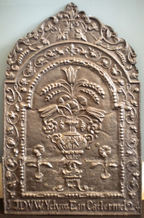-
885
Description: Arched rectangular shaped central panel, bead-and-pellet edging, narrow-necked, two-handled urn with flowers and wheat ears issuing therefrom, the vase resting on a wall with stone courses, against which are two small flowers in pots with a stool between; arched rectangular shaped border with fillet edging and symmetrical floral tendrils, a looped 'W' in each shoulder; on top, mirrored leaves, tendrils and wheat ears; inscription along bottom of border.
Notes: One of the two largest of six flower vase designs in this series (see also no. 858). All incorporate the looped 'W' motif which may be intended to identify the pattern maker. The casting is an amalgamation of parts of two firebacks of the same design, the bottom portion from an earlier casting than the top (reduction 2%). The inscription translates as 'God is our strength'.
Inscription: 17 DVW Ydyw Ein Cadernid 24
Manufactured: in 1724 in England.
Current location: not known.
- Attached to series:
- 1724 series
- British 'Dutch' style firebacks
- Welsh inscription series
